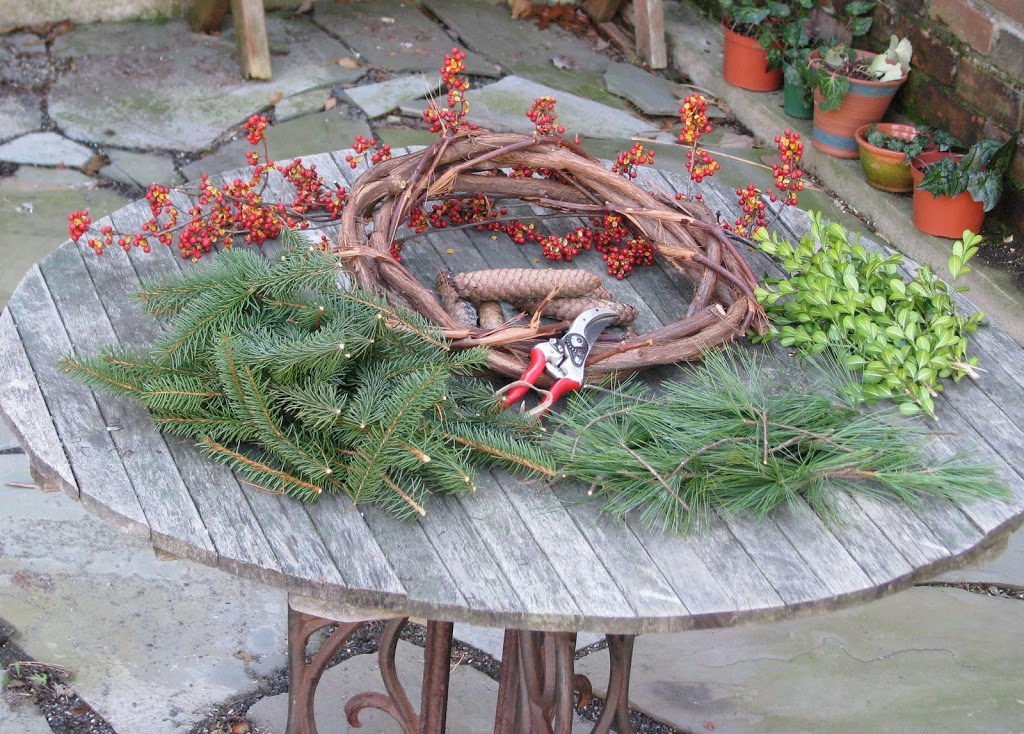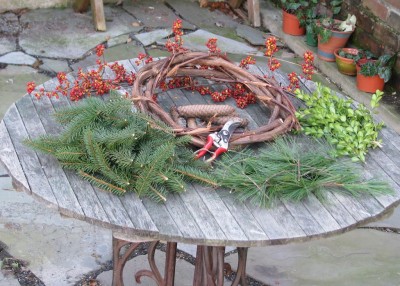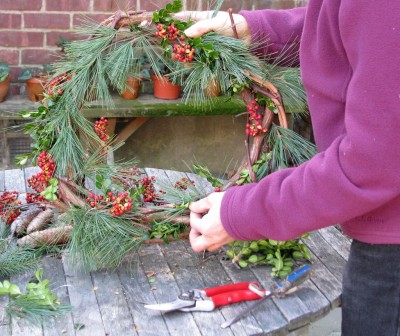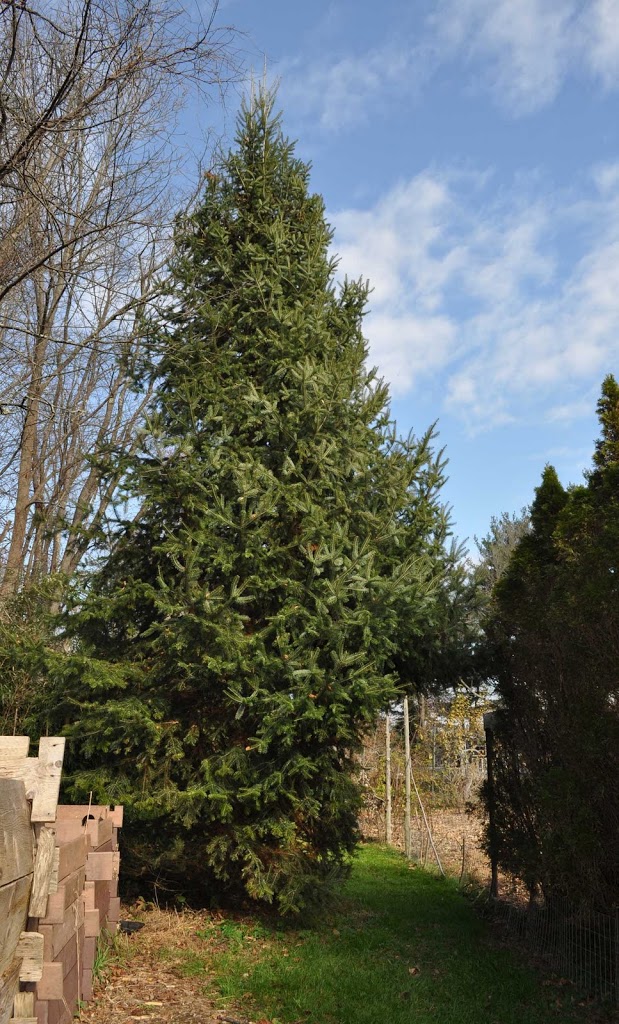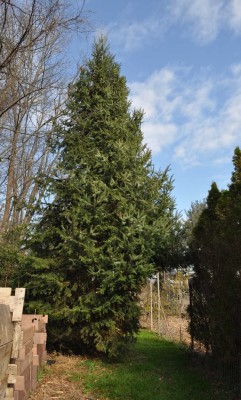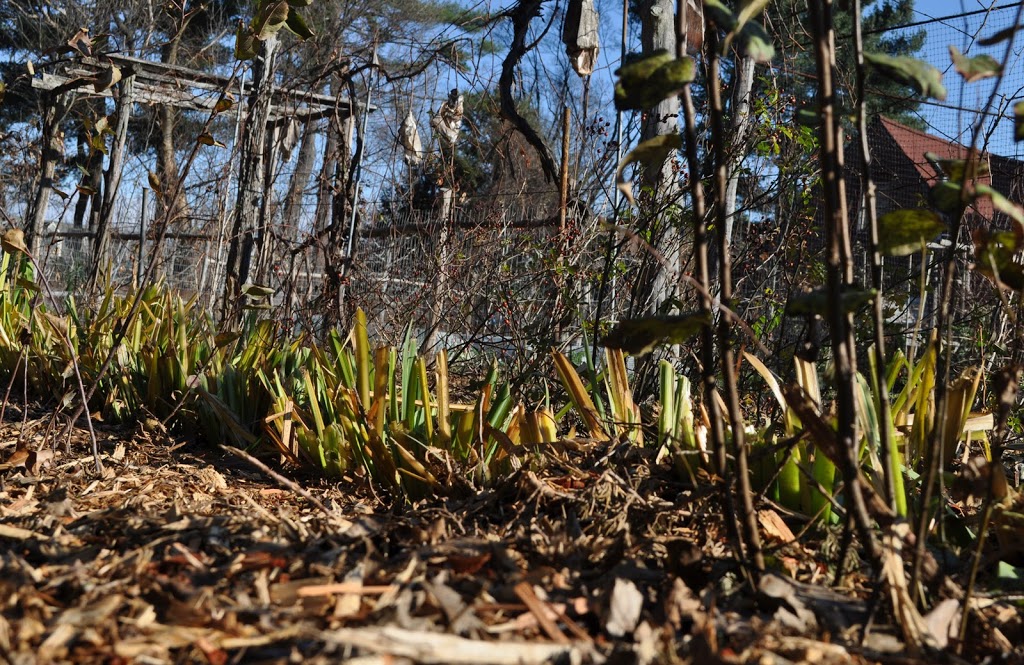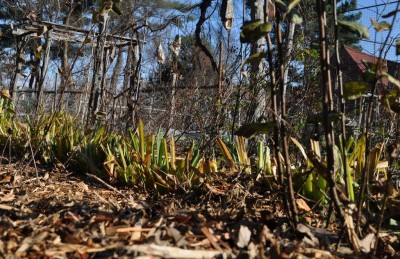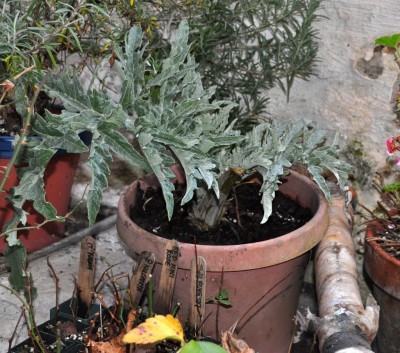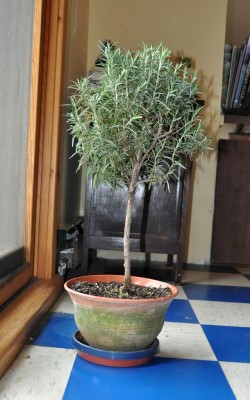HOMEGROWN WREATH
/0 Comments/in Gardening/by Lee A. ReichThe dark green wreath was tied with red ribbons and gliding towards me, in its progress stirring up snowflakes gently floating out of the grey sky. No, the wreath was not hanging from a horse-drawn sled, but was plowing through the frigid air affixed to the chrome grille of a gleaming white Cadillac! Here we are in the twenty-first century, still infusing a breath of life into our winters with cut evergreen boughs, just as did the ancient Egyptians, Persians, Jews, Christians, and Druids.
And it’s true: a few evergreen boughs tied together and accented with a red ribbon do make a doorway more inviting, or a room more cozy in winter. (I’m still undecided about what greenery does for a Cadillac grill.) But going one step further with the greenery, to a bona fide wreath, creates something special. And the actual making of a wreath can be an end in itself this time of year, particularly to the accompaniment of a warm fire and friends and children.
To make a wreath, start with a base. The base might be a sturdy ring of wire (from a coat hanger, for example), or straw that has been bound into a bulky circle with string. Either of these bases can be made from scratch or purchased. For a more natural base, one which might be part of the final design, use a vine such as grape, honeysuckle, wisteria, or bower actinidia. Weave the vine into a circle of triple thickness, tucking in a new piece of vine as an old one ends.
The base might be all, or just about all, that is needed for a simple wreath. I have seen a very attractive wreath that was nothing more than a thick ring of wild rose sprigs showing off a profusion of pastel red fruits. Carefully overlapped sprigs of lavender or rosemary, bound with thin wire to a heavier wire frame, make a dainty, fragrant, blue-green wreath. Thyme is another good plant for this purpose, also fragrant. Keep thyme’s wiry stems somewhat loose, though, because they are as important in adding body to the wreath as are the tiny leaves.
This time of year my penchant is for wreaths that are rich green in color, and almost gaudy with ornamentation. The base for such wreaths is some evergreen plant. Not all evergreens are suitable, because some drop their leaves too readily indoors (and in the brisk wind riding on the front of a car!). Amongst needle-leaf evergreens, juniper, white pine, mugho pine, red pine, and spruce are good choices. Or, for something brighter, needled evergreens with yellow-tipped leaves, such as Gold Star and Kuriwao Sunburst junipers. Mahonia, holly, leucothoe, rhododendron, boxwood, lingonberry, and English ivy are suitable broad-leaf evergreens for a wreath, but none of the broadleaf evergreens will hold their leaves indoors as long as the needle-leaved evergreens.
Wire, glue or tuck small bunches of evergreens onto the base, with all the bunches facing the same direction. Don’t be stingy, because this mass of green color is what is going to calm down and visually hold together the whole wreath.
Next, add accent. Ornaments that are darker shades, and blue or green, make a quieter wreath than ornaments that are lighter shades, and red or yellow. As I said, this time of year I prefer spirited ornamentation, perhaps due to the impending dead of winter. Lively ornaments might include chains of shiny red cranberries or popcorn threaded together, bunches of bright red peppers and garlic clove.
Fruits, like evergreen leaves, flaunt winter’s cold darkness to celebrate the continuity of life from one year to the next. Some brightly colored fruits still clinging to vines and shrubs include mountainash, bittersweet, winterberry, barberry, and, of course, holly. Deck the halls.
XMAS TREE PLANTATION ON MINI-PLOT
/1 Comment/in Gardening, Planning/by Lee A. ReichA living Christmas tree seems the “right” thing to do: You get a holiday tree decorating your living room for a couple weeks; the planet gets a tree to soak up carbon dioxide, provide a playground for wildlife, and contribute to the landscape greenery. The problem is that yearly planting out of living Christmas trees in most yards pretty soon leads to a small-scale version of the Black Forest. A lugubrious and mysterious landscape is not for everyone.
But there is a way to enjoy living Christmas trees, and keep the scene sunny and winsome: Plant very young trees, then harvest them when they reach the size to cut for Christmas. Essentially, have your own tree farm. The tree lives — and you enjoy it as such — until you cut it.
You may imagine that a tree farm big enough to supply you with one tree a year would take up too much space. Not so. A Christmas tree needs about eight years to grow to a harvestable size of about six feet tall. If you have enough space for eight trees, you can cut one and plant a new one every year, for an endless supply. At five foot spacing, all you need is about 200 square feet of area — perhaps a forty foot row, perhaps a rectangular plot ten by twenty feet. This spacing gives each plant enough sun to grow into a well-shaped tree, and allows you plenty of room to mow around each tree. If you prefer smaller Christmas trees, you can plant even closer.
Your tree farm need not be in an out-of-the-way place. A row of trees might make a nice, evergreen hedge. With the wide spacing and variation in tree sizes, the hedge will be somewhat informal. But at least you do not have to worry about the hedge becoming too tall, because trees get removed as soon as they are about head height. The trees also might make a nice screen for your compost bin or dog’s house. How about a miniature forest for your child?
Growing your own trees gives you the option of choosing whatever type of Christmas tree you want. Most commonly cut nowadays for Christmas trees is Scotch pine, a tree that is very cold-hardy, fast growing, and tolerant of many different soil types. And, the plant holds its needles very well indoors.
———————————————-
Scotch pine has been popular only since the 1930s, and over the years many other species have been in favor. In the middle of the 19th century, cedar was a favorite. But it dropped its needles too easily indoors. Then hemlock, one of the fastest growing evergreens, became popular. Its main defect is that its flexible branches bow too far to the ground under the weight of ornaments. Nowadays it’s also beset by a serious insect pest, the woolly adelgid. By the end of the 19th century, balsam fir became popular. This tree, still popular for Christmas in New England, makes up for its deficiencies — slow growth, less than ideal shape, and some needle drop — with its woodsy aroma that is rightly reminiscent of northern or mountaintop forests.
If you grow balsam fir — and I planted a half-dozen of them almost 20 years ago — make sure to give it a cool, moist soil. The climate around here is warmer than usually enjoyed by balsam fir, but I figured that the fragrance made balsam fir worth a try. My dog Stick, then a leashed puppy, soon chewed up 5 of my young trees, which were all that he could reach when he was young and leashed. One survived, and the survivor is now a towering, fragrant beauty about 25 feet tall and so wide that I had to cut an opening in its lower limbs to allow passage past it along the back portion of the garden.
I never could bring myself to cut that sole survivor to bring indoors for the holidays. The tree is so kind as to keep making two leading stems. Cutting one of them lets the other grow and gives me a manageable holiday tree that leaves the remaining tree healthier. If both leading stems were allowed to grow, they would be apt to split apart at their origin.
———————————————————–
Nowadays, besides Scotch pine, other popular Christmas trees include eastern white pine, Norway spruce, white and Colorado spruces, Douglas fir, and Fraser fir. White pine is fast growing, with an open form that you may or may not prefer in a Christmas tree. This native plant tolerates almost any soil, and even a bit of shade. Norway spruce is almost as fast growing, and is a graceful tree with arching limbs along the bottoms of which dangle short, needled branchlets. Norway spruce needs well-drained soil and full sun.
White and Colorado spruce, and Douglas and Fraser firs, are slow-growing trees. (The two firs are unrelated: Douglas is Pseudotsuga menziesii; Fraser is Abies fraserii.) The two spruces require moist, yet well-drained soil, in full sun. Douglas fir needs full sunlight, but cannot tolerate a windy site or dry soil. Douglas fir holds its needles indoors almost as well as does Scotch pine. Fraser fir needs wet soils in full sun or part shade.
A miniature tree farm requires very little time for maintenance. A thick mulch of straw or leaves will conserve soil moisture and smother weeds. Grow grass between the trees and mow it regularly to prevent competition for nutrients and moisture, especially when the trees are very small. If you prefer a tighter growth habit to your trees, and have the time and inclination, prune them once a year, shortening by half the “candles” of new growth before they expand in early summer. And finally, keep teething, playful puppies at bay from any trees for their first couple of years.
Thanks(soil)giving, Chokes, & Rosemary
/6 Comments/in Gardening/by Lee A. ReichAs part of my Thanksgiving celebration, I’m thanking the soil. Soil, after all, is where it all starts. We’re thankful for the plants, but the plants got where they got because of the soil, offering plants support, water, air (which roots need), a friendly microbial environment, and nourishment.
Basically, I thank the soil with organic materials, that is, stuff that is or was living. Stuff like wood chips (dead), straw (dead), compost (living and dead), manure (living and dead), and autumn leaves (dead). Organic materials are what put the “organic” in organic gardening and farming. Organic materials are bulky, and are what chemical fertilizers have too often replaced. Compost, for instance, is about one percent nitrogen, so to supply the average 2 pounds per 1000 square feet of actual nitrogen needed would require 200 pounds of compost. Opt for 10-10-10 chemical fertilizer and a mere 20 pounds per 1000 square feet would do the trick.
Oh, but that 180 pound difference between compost and 10-10-10 offers so much more than just nitrogen. Compost serves up a smorgasboard of nutrients reflecting the diversity of what went into the compost pile. Just about everything goes into mine, including orange peels from California, olive pits from Peru, even my old Levi’s in addition to garden and kitchen waste, hay, and manure.
That’s not all: Compost and, as they decompose, other organic materials, offer a witch’s brew of natural compounds that improve plant nutrition by unleashing nutrients from the soil’s rocky matrix and rendering nutrients already in the soil even more available to plants. As important, these organic materials help soils hold both water and air, and provide a congenial, nutritive environment for beneficial organisms that help plants fend off diseases and further abet plant growth. Whew! That’s a lot of goodness.
So I’m hauling cart after cart of organic materials. Vegetable beds get an inch depth of crumbly, dark, pleasantly fragrant compost from piles built last year. Paths in vegetable gardens get wood chips. I am mulching berry plantings with wood chips or leaves, according to what’s available and my whims. Leaves that drop from the chestnut trees will be supplemented with leaves that neighbors with leafier yards need to discard. Other trees get wood chips. Fruit trees get rotted leaves, which are very similar in composition to compost in addition to wood chips and, possibly, horse manure with wood shavings.
I hope to finish soil Thanksgiving before the first snow that stays.
————————————————————-
My gut reaction is to shy away from eating any plant with “choke” in its name. Chokecherries (Prunus virginiana) are not for me. I did once grow chokeberry (Aronia spp.), which lived up to its name; the plant is long gone. Chokeberry is said to make a tasty jam or juice, which I realized, anything can if given enough sweetener, dilution, and addition of other flavors.
Artichoke is one “choke” worth growing; its “choke” comes not from the throat but from the Arab name for the plant, al-qarshuf. The problem is that artichoke is one choke that isn’t very happy here. It needs mild winters and summers not searing, which are conditions you might find right along the coast in California or the Mediterranean. So, of course, I am growing it here in New York’s Hudson Valley.
I grew artichoke years ago and did harvest a few small buds; this year I was hoping for at least larger buds. Imperial Star is the variety recommended for northern gardens because it forms buds the first year so can be grown as an annual. Not mine. I sowed seeds early this spring after giving this perennial the cold treatment necessary to fool it into thinking it’s gone through a mild winter and can begin flowering. Imperial Star is more easily fooled than other varieties. Plants given to a friend did make a few small buds but my plants just grew. (Northern Star is another, newer possibility for northern gardens because it allegedly survives winter temperatures below zero degrees F.)
No need to throw in the towel in growing artichokes, though. Among my last activities in the vegetable garden is to dig up one artichoke plant, pot it up, and overwinter it in a bright window in my cool basement. I’ll give it a head start in the greenhouse in spring, then plant it outdoors again when the the weather warms. If the harvest is nonexistent or unreasonably small, I’ll abandon artichoke growing for another 15 years.
————————————————————–
Increasingly, my attention is turning indoors. It has to, with all the thirsty plants now sitting in sunny windows. One of the thirstiest, oddly enough, is rosemary. Too many rosemary plants towards the end of too many winters have surprised me by all of a sudden, when brushed against, shedding leaves, dried and dead, as were the plants.
As a Mediterranean plant, you’d assume it likes dryish condition. It does like its head dry, at least in summer. Stiff leaves make it hard to tell when rosemary is thirsty. They don’t wilt, they just dry up and die.
So now I err on the side of too much rather than too little water. With extra perlite, my potting mix is well-drained, making too much water hardly a problem as long as the saucer beneath the plant isn’t filling with water. The best way to tell whether or not a rosemary plant is thirsty is to feel the weight of the pot.
Except for one rosemary plant conveniently growing in the kitchen, the others are spending winter in the basement, along with the artichoke.

